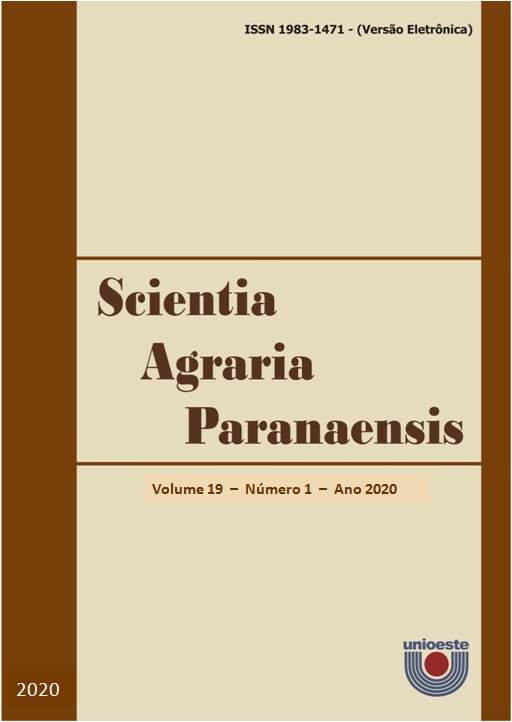Winter cold deficit in low subtropical climate region and blackberry varieties phenology
DOI:
https://doi.org/10.18188/sap.v19i1.23610Resumo
In the western region of Paraná, the subtropical climate prevails, with little accumulation of hours of cold in the winter, making the fruit species not go into complete dormancy. Given the above, the objective of this study was to evaluate the effect of chemical defoliant on blackberry varieties, aiming at their complete defoliation and induction of numbness. The work was conducted at Unioeste, Marechal Cândido Rondon Campus, in a four-year-old orchard of plants, spaced 3 x 0.5 m, simple spreader with two wire strands at a height of 120 cm from the ground, and 20 plants per grow crops. The experimental design used was randomized blocks, where two treatments related to the application of defoliant (with and without) on 7 cvs were evaluated blackberry, containing three replicates and three plants in each cultivar. Was used as a defoliant lime sulfur applied in August pruning then held 25 days after application. Regarding fruit quality, Caigangue and Tupy varieties showed the highest SS/AT ratio, indicating the best flavor of their fruits for fresh consumption. The cultivars Brazos and Guarani showed lower SS/AT ratio, indicating more acidic fruits. Higher levels of ascorbic acid were found in fruits of cvs. Guarani and Cherokee. The application of defoliant reduced the total number of blackberry fruits of the cultivars Comanche and Guarani. The use of defoliant did not interfere in the physicochemical characteristics of the blackberry fruits of the evaluated cultivars.
Downloads
Publicado
Como Citar
Edição
Seção
Licença
Aviso de Direito Autoral Creative Commons
Política para Periódicos de Acesso Livre
Autores que publicam nesta revista concordam com os seguintes termos:
1. Autores mantém os direitos autorais e concedem à revista o direito de primeira publicação, com o trabalho simultaneamente licenciado sob a Licença Creative Commons Attribution que permite o compartilhamento do trabalho com reconhecimento da autoria e publicação inicial nesta revista.2. Autores têm autorização para assumir contratos adicionais separadamente, para distribuição não-exclusiva da versão do trabalho publicada nesta revista (ex.: publicar em repositório institucional ou como capítulo de livro), com reconhecimento de autoria e publicação inicial nesta revista.
3. Autores têm permissão e são estimulados a publicar e distribuir seu trabalho online (ex.: em repositórios institucionais ou na sua página pessoal) a qualquer ponto antes ou durante o processo editorial, já que isso pode gerar alterações produtivas, bem como aumentar o impacto e a citação do trabalho publicado (Veja O Efeito do Acesso Livre).
Licença Creative Commons
Esta obra está licenciada com uma Licença Creative Commons Atribuição-NãoComercial-CompartilhaIgual 4.0 Internacional, o que permite compartilhar, copiar, distribuir, exibir, reproduzir, a totalidade ou partes desde que não tenha objetivo comercial e sejam citados os autores e a fonte.


